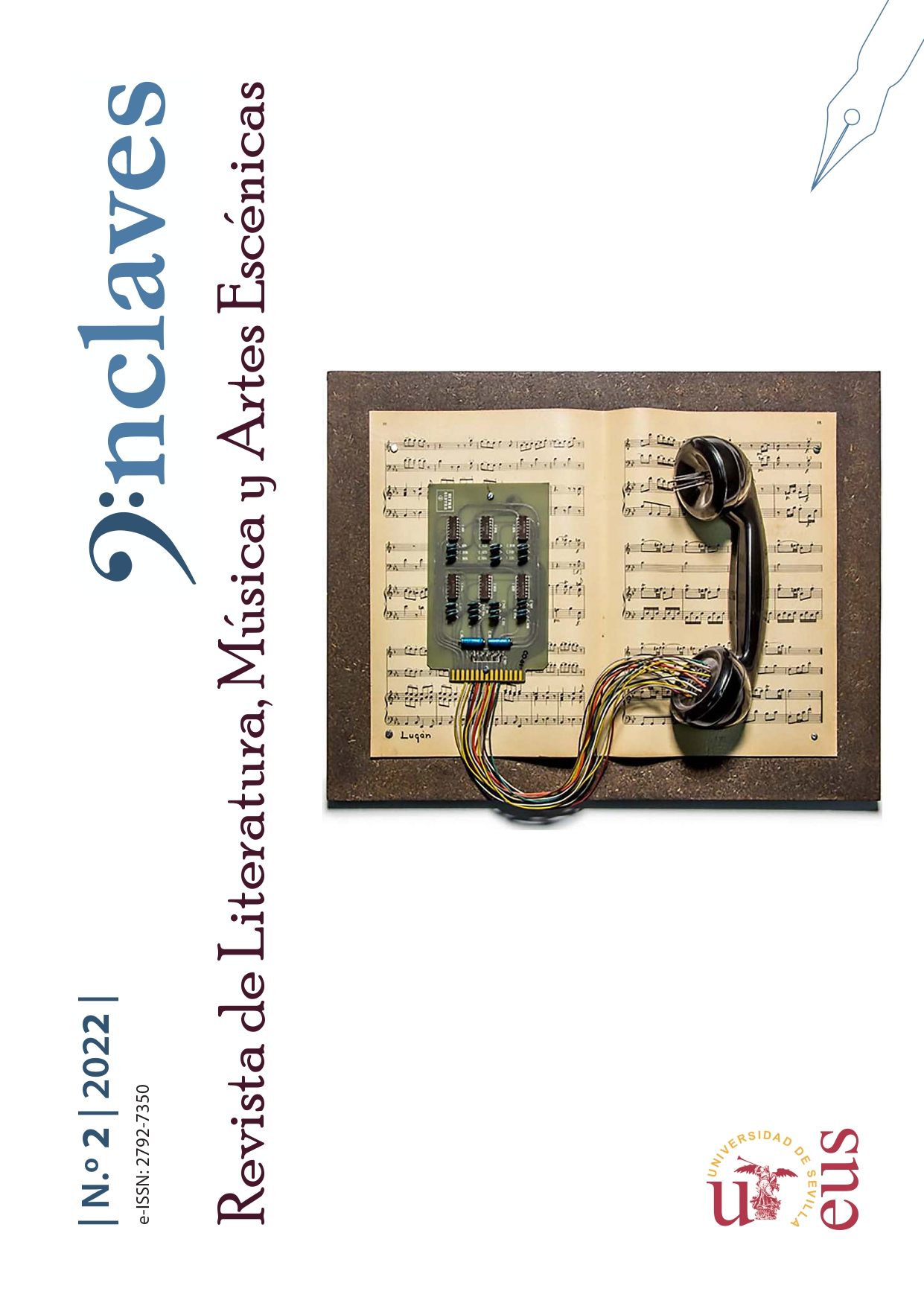Zag Resonances: Esther Ferrer, Sounding at Pleasure
Keywords:
Esther Ferrer, Sound creation, Performance, Body, Voice, ZajAbstract
Esther Ferrer’s artistic practice emanates from the shared pleasure of making, an expressive need that held the creative seams of the Zaj group together, intermittently, for more than three decades. However, this shared pleasure reveals an imbalance with respect to the figure of Ferrer in the assessment of the contributions of its founding members to sound creation. This article seeks to reconsider this imbalance through an investigation into sounding in Esther Ferrer’s work. To approach this sound-making, I will explore the relations between the body and the voice, alongside her conception of performance, with the aim of tracing some of the fundamental pillars of her production: repetition, duration, spatial and temporal structures, and co-presence. Beyond her actions prefixed in scores, I will delve into the hazardous liberation of sound and silence through a selection of sound works spanning fifty years of her career to track an artistic activity that remains open and in continuous variation.
Downloads
Metrics
References
Aizpuru, Margarita. “Esther Ferrer, una mujer de acción”. Esther Ferrer, de la acción al objeto y viceversa. Catálogo de exposición, coordinado por Ana Salaverría. San Sebastián: Diputación Foral de Guipúzcoa, 1998, pp. 8-36.
Allsopp, Ric. “De la mano, del pie…” Before the words. Refugio temporal. Mal Pelo. Catálogo de exposición. Palma: Es Baluard Museu d’Art Contemporani de Palma, 2022, pp. 5-20.
Álvarez-Fernández, Miguel. “Esther Ferrer. Hacia Al ritmo del tiempo”. La radio ante el micrófono. Voz, erotismo y sociedad de masas. Bilbao: Consonni, 2021, pp. 181-214.
Barber, Llorenç. Zaj. Historia y valoración crítica. Murcia: CENDEAC, 2019.
Barce, Ramón. “Músicas en carne y hueso”. Minerva: Revista del Círculo de Bellas Artes, n.º 10, 2009, pp. 67-69, https://cbamadrid.es/revistaminerva/articulo.php?id=308. Acceso 12 septiembre 2022.
Castro Flórez, Fernando. “Esther Ferrer. Para mantener la distancia justa”. Cuidado y peligro de sí. Procesos artísticos y dinámicas políticas en tiempos de pandemia, Logroño: Los Aciertos, 2012, pp. 11-14.
Charles, Daniel. “Zaj: Tao y posmodernidad”. Fuera de formato, coordinado por Concha Jerez, Madrid: Centro Cultural de la Villa, 1983, pp. 163-164.
Chion, Michel. El sonido. Música, cine, literatura… Barcelona: Paidós, 1999.
Collado, Gloria. “Gauzak/Las cosas/The things”. Esther Ferrer. De la acción al objeto y viceversa. Catálogo de exposición, coordinado por Ana Salaverría. San Sebastián: Diputación Foral de Guipúzcoa, 1998, pp. 35-47.
Deleuze, Gilles, y Félix Guattari. “Año cero, rostridad”. Mil mesetas. Capitalismo y esquizofrenia. Valencia: Pre-Textos, 2002, pp. 173-196.
“Dossier de prensa. Esther Ferrer. Espacios entrelazados”. Guggenheim Bilbao, https://prensa.guggenheim-bilbao.eus/src/uploads/2018/02/Dossier-Esther-Ferrer_ES-1.pdf. Acceso 5 noviembre 2023.
Ferrer, Esther. “Fluxus & Zaj”. Estudios sobre performance, coordinado por Gloria Picazo, Sevilla: Centro Andaluz de Teatro, 1993, pp. 31-47.
Ferrer, Esther. “Fluxus & Zaj”. Zehar. Boletín de Arteleku, n.º 28, 1994-1995, pp. 22-25.
Ferrer, Esther. “Le livre du sexe / Le livre des têtes”. Le Cahier du Refuge, n.º 64, 1998, pp. 5-14, http://cipmarseille.fr/publication_fiche.php?id=6a2f5885dafb3d1386fd77005da3aab3. Acceso 15 septiembre 2022.
Ferrer, Esther. “Todas las sonrisas del mundo”. Revista LÁPIZ – Revista Internacional de Arte, n.º 149/150, 1999, pp. 38-41.
Ferrer, Esther. “Obras sonoras”. Todas las variaciones son válidas, incluida esta. CD, catálogo de exposición. Madrid: Museo Nacional Centro de Arte Reina Sofía, 2017.
Ferrer, Esther. Entretien avec Camille Paulhan. París: Manuella Éditions/AWARE, 2021.
Ferrer, Esther, et al. “Todas las variaciones son válidas, incluida esta”. Todas las variaciones son válidas, incluida esta. Catálogo de exposición. Madrid: Museo Nacional Centro de Arte Reina Sofía, 2017, pp. 53-108.
Jerez, Concha, coord. Fuera de formato. Madrid: Centro Cultural de la Villa, 1983.
LaBelle, Brandon. Lexicon of the Mouth. Poetics and Politics of Voice and the Oral Imaginary. Londres: Bloomsbury Academic, 2014.
“Las risas del mundo”. Guggenheim Bilbao, https://www.guggenheim-bilbao.eus/la-coleccion/obras/las-risas-del-mundo. Consultado 12 septiembre 2022.
Lepecki, André. “Toppling dance”. Exhausting Dance. Performance and the Politics of Movement, Nueva York: Routledge, 2006, pp. 76-86.
Nancy, Jean Luc. Ego sum. Barcelona: Anthropos, 2007.
Novak, Jelena. “Singing Beyond the Body: Uniqueness, Intruder and Prosthesis”. Postopera. Reinventing the Voice-Body, Farham: Ashgate, 2015, pp. 41-55.
Olivares, Rosa. “La artista como la obra de arte”. Esther Ferrer. En catro movementos. En cuatro movimientos. In four movements. Catálogo de exposición, dirigido por Rosa Olivares. Vitoria: Sociedad Estatal de Acción Cultural/Fundación Artium de Álava, 2012, pp. 14-37.
Pitozzi, Enrico. “Corpo sonoro collettivo. Verso una tattilita uditiva”. Digimag, n.º 51, febrero, 2010, s/p, http://digicult.it/it/digimag/issue-051/a-collective-resounding-body-aiming-towards-an-auditory-tactility/. Acceso 12 septiembre 2022.
Restrepo Mesa, Sergio. “Aproximación al teatro musical y la música conceptual a través del análisis estético, estilístico y estructural de Los Holas, Música-Etc. 1966 en tres tiempos, de Juan Hidalgo”. Cuadernos de Música, Artes Visuales y Artes Escénicas, vol. 2, n.º 1, 2005, pp. 240-267.
Rivière, Henar. “Zaj. De la música de acción al arte sonoro”. Escuchar con los ojos. Arte sonoro en España, 1961-2016. Catálogo de exposición, editado por Manuel Fontán del Junco, et al., Madrid: Fundación Juan March, 2016, pp. 129-141.
Rodríguez Prieto, Zara, coord. “Entrevista colectiva a Esther Ferrer”. Efímera Revista, vol. 7, n.º 8, noviembre, 2016, s/p.
Rodríguez Súnico, María Teresa. “El caudal del arte de acción. La trayectoria artística de Esther Ferrer”. Tesis doctoral, Universidad de Sevilla, 2001.
Rozas, Ixiar. Beltzuria. Madrid: Enclave de Libros, 2017.
Rozas, Ixiar. Sonar la voz. 9 ensayos y 9 partituras. Bilbao: Consonni, 2022.
Salgado, María. “Una acción, un cuadrado, un piano”. Todas las variaciones son válidas, incluida esta. Catálogo de exposición. Madrid: Museo Nacional Centro de Arte Reina Sofía, 2017, pp. 153-184.
San Martín, Francisco Javier. “Exponer la música. Entrevista con Esther Ferrer”. Revista LÁPIZ – Revista Internacional de Arte, n.º 156, octubre, 1999, pp. 39-48.
Sánchez, José Antonio. Prácticas de lo real en la escena contemporánea. Ciudad de México: Toma, Ediciones y Producciones Escénicas y Cinematográficas, 2012.
Sarmiento, José Antonio, ed. Zaj. Catálogo de exposición. Madrid: Museo Nacional Centro de Arte Reina Sofía, 1996.
Vallee, Mickey. Sounding Bodies, Sounding Worlds. An Exploration of Embodiments in Sound. Singapur: Palgrave Macmillan, 2020.
Vaquero, Natalia. “Juan Hidalgo: Soy el más transgresor de los artistas españoles”. Faro de Vigo, 18 de enero de 2015, pp. 68-69, https://www.farodevigo.es/sociedad/2015/01/18/juan-hidalgo-transgresor-artistas-espanoles-17017935.html. Acceso 17 septiembre 2022.
Waltham-Smith, Naomi. Shattering Biopolitics. Militant Listening and the Sound of Life. Nueva York: Fordham University Press, 2021.
Downloads
Published
How to Cite
Issue
Section
License
Copyright (c) 2022 Carmen Noheda

This work is licensed under a Creative Commons Attribution-NonCommercial-NoDerivatives 4.0 International License.
- Abstract 165
- PDF (Español (España)) 79








